Gyoda City, Saitama埼玉県行田市
Living in Gyoda City, Saitama

We have Summarized the livability of Gyoda City, Saitama.
TONE AREA利根地域
CONTENTS
- What kind of place is Gyoda City?
- Gyoda CityPR video
- How is the traffic situation in Gyoda City?
- How are the rent and land prices in Gyoda City?
- How is childcare and education in Gyoda City?
- How about shopping in Gyoda City?
- How about jobs and recruitment in Gyoda City?
- Gyoda City’s unique subsidy/subsidy system
What kind of place is Gyoda City, Saitama?
 Panoramic view from Gyoda Station
Panoramic view from Gyoda Station
Gyoda City, a city rich in nature and history
Gyoda City is located in the northwest of the Tone region of Saitama Prefecture.
The area is surrounded by Hanyu City and Kazo City to the east, Kumagaya City to the west, and Konosu City to the south.
Gyoda City, located in the northern part of Saitama Prefecture, is known for its good public safety and quiet residential areas, and has a population of about 80,000 and about 35,000 households.
The ratio of men to women is almost the same, with slightly more women than men, but both are about 40,000.
Gyoda City is famous nationwide for its large ancient tombs, and the Saitama Ancient Tomb Group in particular has been designated as a special national historic site.
Geographically, it is located south of the Tone River, and is adjacent to Gunma Prefecture across the river.
The entire area of Gyoda City is an alluvial plain with the Tone River and the Arakawa River, and is characterized by a flat topography with almost no elevation difference.
Although it does not directly contact the Arakawa River, it is adjacent to the levee that protects it from flooding of the Arakawa River.
Historically, it is said to be the birthplace of the place names of Saitama Prefecture, which appear in the Manyoshu, and has many valuable cultural assets from the Kofun period and records from later periods, making it a city with a long history.
The town of tabi, which was also a hot topic in the TBS drama “Rikuo”
Gyoda City is a producer of tabi, known for Gyoda tabi, and is a city that has been certified as a Japan Heritage site as Gyoda, a town of tabi warehouses that continues to support the feet of Japanese clothing culture.
Tabi production began and became full-scale after the mid-Edo period, when it was a side job for low-ranking samurai.
It was after the Meiji period, when production efficiency improved significantly due to mechanization, that the number of production increased significantly and it became famous nationwide.
Although tabi socks have now fallen into decline due to the popularity of synthetic fiber socks, production of tabi socks continues, and the industry is trying to survive by switching from tabi socks to the textile industry.
PR video of Gyoda City, Saitama
Video introducing the attractions of Gyoda City
Gyoda City Tourism Promotion Video
How is the traffic situation in Gyoda City?
 Gyoda Station South Exit
Gyoda Station South Exit
Gyoda City, where the Chichibu Railway and JR Takasaki Line pass
There are train stations at Gyoda Station on the JR Takasaki Line, and Mochida Station, Gyoda City Station, and Bushu Araki Station on the Chichibu Railway. From JR Gyoda Station, you can access Tokyo Station in 70 minutes, so this is a recommended town for those who want to spend their weekends relaxing in the countryside.
The center of the city is Gyoda City Station on the Chichibu Railway. There is a station with a similar name, Gyoda Station, but this is a station on the JR Takasaki Line that runs through the southwest side of the city.
Although the Chichibu Railway runs through the center of the city, it is not directly connected to the city center, and the Takasaki Line is responsible for access to the city center.
If you want to access the city center by using the Chichibu Railway, you will need to transfer at Kumagaya Station or Hanyu Station.
Gyoda City: A city with convenient car access
There are no expressways, but within 30 minutes by car, there are the Hanyu IC and Kazo IC on the Tohoku Expressway, and the Okegawa Kano IC on the Metropolitan Intercity Expressway.
The Higashimatsuyama IC on the Kanetsu Expressway is also within 30 minutes, but both ICs are in neighboring cities, not Gyoda City.
General roads include National Route 17 and 125, Prefectural Routes 128 to 364, and Local Routes 7 to 77.
The general prefectural roads are particularly well-developed and connect all directions, so although there are no expressways, they support the convenience of car access instead.
There are currently no so-called roadside stations, but there are plans to build one on National Route 125.
Buses are operated by Asahi Motors and Kokusai Jyuoh Kotsu, subsidiaries of Tobu Bus, which once provided transportation for the city’s residents. The taxi is operating in the northern part of the prefecture, in the same area as Kumagaya City, Fukaya City, Honjo City, Kazo City, and Hanyu City.
From Gyoda Station, you can access Shinjuku Station and Tokyo Station without changing trains. Convenient main roads run through the city, making it easy to access neighboring cities.
It takes about an hour and 15 minutes to get from Gyoda Station to downtown Tokyo, so commuting to work or school may be difficult.
How are the rent and land prices in Gyoda City?
Gyoda City is an easy place to live for families and where you can even build your own custom-built home.
According to SUUMO, the average rental price for a condominium or apartment in Gyoda City is around 56,000 yen for a 1LDK and 60,000 yen for a 2LDK. This is a relatively low price, so it’s a budget-friendly area for young families.
The average land price for the entire city of Gyoda is around 118,000 yen per tsubo. However, if you’re looking for land in a good location, such as near a station, the average price will be over 400,000 yen per tsubo.
The relatively low rental prices give families more options when searching for properties. Land prices are also affordable, making it possible to build a stylish single-story house or a custom-built home.
In areas that are not close to stations, a car is a necessity, so you will need parking spaces for the number of cars you own.
How is childcare and education in Gyoda City?
 Sakitama Burial Mounds
Sakitama Burial Mounds
Supporting Families with Children in Gyoda City
Gyoda City is committed to creating a place where “children and parents can live happily and safely.” The city is dedicated to providing a seamless environment for safe childbirth and child-rearing. Key initiatives include establishing and enhancing consultation services, disseminating information on pregnancy, childbirth, and child-rearing, and expanding support systems. The city focuses on daycare centers and kindergartens, with one of its key initiatives being the realization of a system for free early childhood education and childcare.
Moreover, Gyoda City supports families with children through various means such as health check-ups, vaccinations, assistance with school supplies and educational costs, and numerous allowances. For children under 18 who are enrolled in health insurance, the city offers a child medical expense assistance system, which covers out-of-pocket costs for insured medical services. In contrast to many municipalities that only offer assistance up to junior high school, Gyoda City provides extensive services for families with children.
Additionally, there is support for single-parent households, along with the expansion of parenting communities and various benefits for families. The city offers robust support for those struggling with parenting challenges, including emergency care for children’s infections and injuries, as well as accessible consultation services for difficult times. Educational institutions such as Monozukuri University and Saitama Prefectural Shinshukan High School are well-known, along with horticultural vocational schools that train experts in flowers and greenery, like the Techno-Horti Horticultural Vocational School. Thus, Gyoda City is a place where comprehensive support is available from pregnancy through childbirth and beyond, making it a safe environment for education as well.
Subsidies are generous, so it is a relief for those raising children. In addition, the environment is one in which history can be experienced up close, with castles and ancient tombs, so it is possible to provide an intellectual education.
There are few leisure spots where children can enjoy themselves.
How about shopping in Gyoda City?
Gyoda City has a wide variety of supermarkets
There are supermarkets scattered throughout Gyoda City, such as Beocia, Berg, Yaoko, and Mommy Mart, so you will never run out of groceries.
There are also a number of specialty stores, such as car accessory stores, so you can shop for car maintenance and care, as well as other hobbies.
The area around Gyoda City Station, the central station, seems to have more restaurants, tourist information, and community centers than shopping.
The area around Gyoda Station is better for shopping than Gyoda City Station, and there are shopping malls, 100-yen shops, flower shops, and Japanese sweets shops.
There are a fair number of restaurants, just like Gyoda City Station, and what they have in common is that there are ramen shops and cafes scattered throughout.
Large commercial facilities are more likely to be found along major streets, such as National Route 17, rather than near stations.
Baby goods stores and other similar stores tend to be more abundant in areas accessible by car than in areas accessible on foot from the station.
There are many supermarkets, so you will never have trouble buying food and daily necessities.
If you want to go to a large shopping mall that you might enjoy, you will have to drive to a nearby area.
How about jobs and recruitment in Gyoda City?
Gyoda City: Jobs for everyone from young people to the elderly
Gyoda City has a wide range of jobs and job offers because of the wide age range of the elderly people living there.
Inevitably, it is a city where you cannot live conveniently without a car, so there are surprisingly many jobs that require the use of a car.
In other words, a driver’s license is likely to be required to apply for a job, so those who have a license can choose a job and are more likely to be interviewed.
Although it is a city rich in nature with fields and farmland, there are not many jobs that involve working in rice fields or farmland.
Most job offers for people in their 40s and above are light work in delivery and logistics, and there are also job offers in manufacturing and cleaning.
Next, there are also job offers in the indispensable fields of restaurants, medicine, and nursing care.
If you want to work as a full-time employee rather than a part-timer, you should aim for a job where you can use your experience and qualifications.
There are a wide variety of job offers, such as forklift operators, ingredient inspections for cosmetics manufacturing, large truck drivers, and warehouse management.
It’s not uncommon to find job offers that allow you to become a full-time employee from a contract position, and there are many jobs where you can use your skills in your field, such as answering questions, entering data, and managing an e-commerce site.
In any case, you won’t have any trouble finding work in Gyoda City if you don’t mind, and if the conditions match, you can work in Gyoda City with attractive benefits.
Gyoda City, Saitama’s unique subsidy/subsidy system
Gyoda City, Saitama’s unique relocation assistance and relocation subsidy system
| Living in Gyoda |
Gyoda City, Saitama’s unique housing assistance and subsidy system
Gyoda City, Saitama’s unique childcare support system
| Floating Castle Town – Joy of Raising Children Project |
Gyoda City, Saitama’s unique system for further education and tuition assistance/subsidies
| Tuition support fee School entrance preparation loan |










